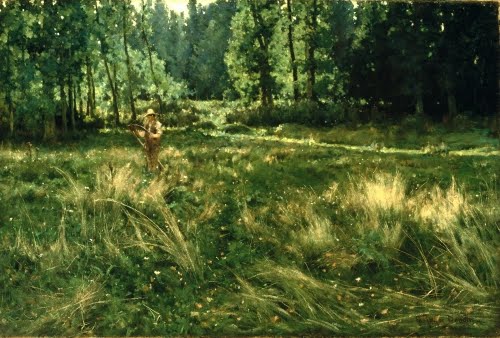I See Green! Gaines Ruger Donoho
No, I’m not seeing “green” as in a stack of cash or a salad on my supper plate. We had a recent snow melt, and I actually saw grass that looked greenish. In mid-winter, that’s like an epiphany to see greenish grass, like spring is just around the corner. Of course, it isn’t, but when I saw this digital image we recently acquired from the Brooklyn Museum, it made me dream of warmer days. Dreaming is good in winter!
 |
| Gaines Ruger Donoho (1857–1916, United States), La Marcellerie (near Grez-sur-Loing, France), 1881. Oil on canvas, 51" x 76 9/16" (129.5 x 194.5 cm). © 2018 Brooklyn Museum. (BMA-5428) |
Gaines Ruger Donoho (1857–1916)—known as Ruger Donoho—was of the generation of American artists who grew up during the Civil War period (1860–1865). Before the Civil War, most American artists who sought to broaden their artistic training went to London. After the Civil War, most American artists turned away from the stale, academic, classicism-obsessed styles prevalent in Britain, and looked to more progressive schools, such as those of Munich and, especially, Paris. Artists in those two European cities were also bucking the conservative, academic domination of the art world.
Donoho was born in Mississippi; grew up in Washington, DC; and attended Millersville State Normal School (now Millersville University) in Pennsylvania from 1874 to 1876. For a while, he worked in a government architectural office, and may have studied painting under Robert Swain Gifford (1840–1925) and Jervis McEntee (1828–1891). McEntee was a Hudson River School painter and Gifford was heavily influenced by the Barbizon landscape “school” of French Realism.
In 1878 he enrolled in the new Art Students League in New York, where he studied under future American Impressionist William Merritt Chase (1849–1916). Chase had studied in Munich, where he adapted a style that combined the Impressionist interest in light and color with the sharp contrasts of dark and light of Baroque art. Donoho left after a year and went to Paris to study at the conservative Academy Julien. However, he also spent summers in the area of Fontainebleau, where the realist Barbizon School encouraged artists to paint outdoors directly from nature, a key inspiration for Impressionism. Barbizon was named after a town near Fontainebleau, which was a focal point for many landscape painters of the Realist movement.
Donoho’s landscapes do not have the same high-key color palette as Impressionism. In fact, he used the green-brown-yellow underpainting palette that was traditional for academic landscape painters. However, he used that palette to instill his landscapes with the exciting ambience of observed light. This painting may resemble early Monet paintings of the 1860s, where he showed a thrill at the raking light of early morning or late afternoon.
I’m intrigued with the title of this painting. Marcelle in French is a word for t-shirt. I’m not sure why this particular place was given that name. I’d love to have to wear one right about now, however.


Comments